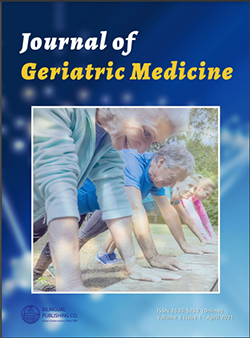 Correction & Withdrawal Policies
Correction & Withdrawal Policies
Postoperative Delirium in Elderly Patients May Be Associated with Perioperative Blood Pressure Fluctuations
DOI:
https://doi.org/10.30564/jgm.v3i1.2892Abstract
Postoperative delirium (PD) is a common complication of surgery in elderly patients, but its pathophysiological mechanism remains unclear. In order to clarify the role of intraoperative hypotension and fluctuation of blood pressure in the development of PD, we conducted a follow-up study in elderly patients with intraoperative hypotension and fluctuation of blood pressure. A total of 237 patients underwent hip surgery between July 2018 and September 2019, and 158 patients who were eligible for inclusion were enrolled in the study. One day before the operation, the mentality of patients was evaluated by Mini-mental State Examination (MMSE), and the sex, age, height, and weight of the patients were recorded. Radial artery puncture was performed in all patients before anesthesia, intraoperative SBP, MAP and DBP were recorded, and the surgical events of the patients was recorded. The markers associated with PD (TNF-α, IL-6 and S-100β) were determined before and after surgery. Perioperative delirium (PD) was assessed by the prevailing standard of assessment, Confusion of Consciousness Assessment (CAM). Cognitive assessment was evaluated using the Mini-mental State Examination (MMSE). In addition, the timing and type of delirium were recorded. There were 158 patients which were accorded with the inclusion criteria came into the study. The results of our data showed that delirium occurred in 41 patients (25.9%) during the first week after surgery. In the comparison between the PD group and the non-PD group, it was found that the patients with postoperative delirium were older, lower body mass index and higher MMSE score before operation. Intraoperative blood pressure is low, usually more than 30% lower than preoperative blood pressure. The levels of TNF- α, IL-6 and Smur100 β were higher after operation. The increased incidence of postoperative delirium may be related to intraoperative hypotension and intraoperative blood pressure fluctuation. The pathophysiological mechanism may be that hypotension causes low cerebral perfusion, which in turn causes local inflammation in the brain. In addition, postoperative delirium is also more likely to occur in older patients with lower body mass index.Keywords:
Perioperative Period; Blood Pressure Fluctuation; Postoperative DeliriumReferences
[1] McCusker J, Cole MG, Dendukuri N, Belzile E. Does delirium increase hospital stay? J Am Geriatr Soc 2003; 51: 1539-46.
[2] Steiner LA. Postoperative delirium. Part 2: detection, prevention and treatment. Eur J Anaesthesiol 2011; 28: 723-32.
[3] Tognoni P, Simonato A, Robutti N, et al. Preoperative risk factors for postoperative delirium (POD) after urological surgery in the elderly. Arch Gerontol Geriatr 2011; 52: e166-9.
[4] Inouye SK, Westendorp RG, Saczynski JS. Delirium in elderly people. Lancet 2014;383:911-22.
[5] Dubljanin-Raspopovic E, Markovic Denic L, Marinkovic J, et al. Use of early indicators in rehabilitation process to predict one-year mortality in elderly hip fracture patients. Hip Int. 2012;22(6):661- 667.
[6] Kat MG, Vreeswijk R, de Jonghe JF, et al. Long-term cognitive outcome of delirium in elderly hip surgerypatients. A prospective matched controlled study over two and a half years. Dement Geriatr Cogn Disord. 2008;26(1):1-8.
[7] Chow WB, Rosenthal RA, Merkow RP, et al. Optimal preoperative assessment of the geriatric surgical patient: a best practices guideline from the American College of Surgeons National Surgical Quality Improvement Program and the American Geriatrics Society. J Am Coll Surg. 2012;215(4):453-466.
[8] Meagher DJ, Leonard M, Donnelly S, et al. A longitudinal study of motor subtypes in delirium: relationship with other phenomenology, etiology, medication exposure and prognosis. J Psychosom Res. 2011;71(6):395-403.
[9] Mosk CA, Mus M, Vroeman J, van der Ploeg T, Vos DI, Elmans LHGJ, et al. Dementia and delirium, the outcomes in elderly hip fracture patients. Clinical Interventions in Aging 2017; 12:421-30.
[10] Khurana V, Gambhir IS, Kishore D. Evaluation of delirium in elderly: a hospital-basedstudy. Geriatr Gerontol Int 2011; 11 467-73.
[11] Hamner JW, Tan CO, Tzeng YC, Taylor JA. Cholinergic control of the cerebral vasculature in humans. J Physiol 2012; 590: 6343-52.
[12] Bell JJ, Pulle RC, Crouch AM, et al. . Impact of malnutrition on 12-month mortality following acute hip fracture. ANZ J Surg 2016;8686:157-61.
[13] Zhu CW, Livote EE, Scarmeas N, et al. Long-term associations between cholinesterase inhibitors and memantine use and health outcomes among patients with Alzheimer’s disease. Alzheimers Dement. 2013;9(6):733-740.




 Daxu Peng
Daxu Peng





